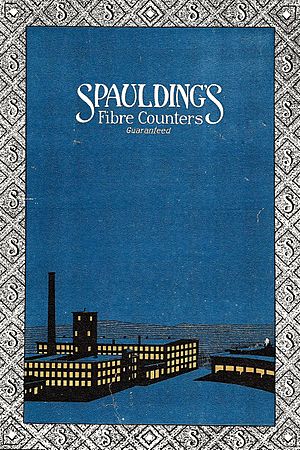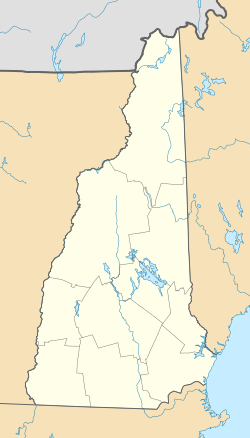North Rochester, New Hampshire facts for kids
Quick facts for kids
North Rochester, New Hampshire
|
|
|---|---|

1915 catalog cover for "Spaulding's Fibre Counters Guaranteed", showing a rendering of the North Rochester plant at night.
|
|
| Country | United States |
| State | New Hampshire |
| County | Strafford |
| City | Rochester |
| Elevation | 275 ft (84 m) |
| Time zone | UTC-5 (Eastern (EST)) |
| • Summer (DST) | UTC-4 (EDT) |
| Area code(s) | 603 |
| GNIS feature ID | 868810 |
North Rochester is a small community located within the city of Rochester, New Hampshire, in the United States. It is known for being the location of a large factory built by Jonas Spaulding. His sons, Huntley N. and Rolland H., later became governors of New Hampshire.
Contents
Exploring North Rochester's Location
North Rochester is found in the northern part of the city of Rochester. The Salmon Falls River flows along its eastern side. This river also forms the border between New Hampshire and Maine. Just north of North Rochester is the town of Milton, New Hampshire.
Roads and Travel
New Hampshire Route 125, also called Milton Road, runs right through the middle of North Rochester. If you drive north on this road, you'll reach Milton in about 2.5 miles. Driving south for about 5 miles will take you to downtown Rochester. The Spaulding Turnpike (New Hampshire Route 16) also runs along the western edge of the community.
The History of North Rochester's Mills
After his first factory in Milton was busy, Jonas Spaulding looked for another place to build. An engineer named Ira Jones suggested an old mill site in North Rochester. This spot was known for the beautiful rippling water of the Salmon Falls River. People used to enjoy a scenic buggy ride that passed by this very spot.
Building the New Factory
Jonas Spaulding decided this was a great location. He started building a second factory for making "leatherboard" here. Leatherboard is a strong material made from processed leather fibers, often used in shoes.
The first step was to build a canal with strong stone walls. This canal was 100 feet long and 20 feet wide. The stone walls were very thick, between 6 and 10 feet. Next, a solid stone block, 20 feet square, was built to hold the mill wheel.
The Dam and Spaulding Pond
A dam was then built across the Salmon Falls River. It was 160 feet long. This dam created a body of water called Spaulding Pond, which stretches north for a mile into Milton. The factory building itself was huge, measuring 52 by 200 feet and standing four stories tall. It was built with very strong, large timbers. When this new factory opened, it could produce about 7 tons of leatherboard each day, just like the Milton factory.
Growth of the Spaulding Company
Jonas Spaulding passed away in 1900, before the North Rochester factory was fully finished. His son, Leon C. Spaulding, became the president of J. Spaulding & Sons Company. After the North Rochester factory was completed, the Spaulding brothers started other businesses. These new companies used the leatherboard their factories produced.
In 1900, they added special machines to the North Rochester plant to make shoe counters. Shoe counters are parts that give shoes their shape. In 1902, the brothers bought Kennebunk Manufacturing Co. in Kennebunk, Maine. This company made fiberboard lunch boxes and later made violin cases and radio speaker horns.
Also in 1902, the Spaulding brothers started Spaulding Perkins, which made fiberboard containers. This company grew into what is now Bayhead Products Company. They also brought their other family businesses under the J. Spaulding & Sons Company name. In 1906, they bought a special machine for the North Rochester plant. This machine helped them create a new type of material called vulcanized fibre, which led to a big factory in Tonawanda, New York.
Changes and Challenges
The company's name changed to Spaulding Fibre Company in 1924. Leon Spaulding, one of Jonas's sons, passed away in 1924. He had been managing the expansion of the Tonawanda factory. Rolland Spaulding, another son, died in 1942. The Spaulding family was known for helping the community, including the Frisbie Memorial Hospital in Rochester.
A big fire destroyed the North Rochester factory in 1944. But it was rebuilt and reopened in 1946. Huntley N. Spaulding, the last surviving son of Jonas, helped lay the cornerstone for the new building. The rebuilt factory was designed to make special insulation board for transformers. When it reopened, it was considered the most modern fiberboard factory in the world.
The North Rochester plant was very important to the Spaulding family's business. The company's main offices stayed in Rochester until Huntley's death in 1955. After that, the offices moved to Tonawanda in 1960. After Huntley's death, the Spaulding Fibre Company became part of a special charitable trust. This trust was set up by Huntley and his sister, Marion S. Potter, to give away their wealth to good causes. Marion passed away in 1957.
Images for kids






